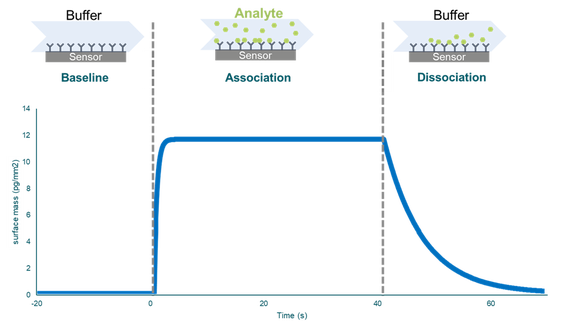
WAVEsystem
創薬およびライフサイエンス向けの次世代バイオ解析装置で、産業研究と学術研究の両方に対応
分子相互作用と結合イベントの正確な測定
結合定数とは、分子間相互作用および2つ以上の分子間の結合反応を測定するときに使用される、速度論的パラメータです。結合速度定数(ka、kon、またはオン速度)は、1 つの分子が2番目の分子と結合して複合体を形成する速度です。1秒あたりのモル数(分子数の標準的な定量化)で記録されます:M-1s-1。
Creoptix技術であるWAVEsystemなどの一部のバイオセンサーを使用して結合速度を分析する場合、1つの分子がバイオセンサー表面(チップ)に固定され、「リガンド」と呼ばれます。2番目の分子はマイクロ流体の流れを通過し、「分析物」と呼ばれます。
右の画像:結合相互作用の測定から得られた曲線(センサーグラム)
まず、緩衝液を固定化リガンドがあるセンサーに流すことで、ベースラインが確立されます。この後、サンプル(分析物)が通過します。分析物は、結合段階でリガンドと結合します。ここから、結合定数は、分析物がリガンドに結合して標準濃度で複合体を形成する速度として計算することができます。これが1秒あたりのモル数で表される理由です。
結合速度と解離速度(kd)は合わせて、親和性(平衡解離定数、KD)を定義し、結合速度(2つの分子間の動的相互作用)を決定します。KD はkd/kaとして計算され、平衡時にリガンドの半分が検体によって占有される検体濃度を決定します。


創薬およびライフサイエンス向けの次世代バイオ解析装置で、産業研究と学術研究の両方に対応
分子間相互作用と結合反応の正確かつ効率的な測定は、さまざまな基礎研究の重要な要素であり、創薬開発プログラムには欠かせない構成要素です。
WAVEsystemは、結合速度を測定する際に結合定数を測定できる光学バイオセンサーです。
| 仕様 | WAVE | WAVEdelta |
|---|---|---|
| 結合定数。範囲 |
ka = 103 –5x107 M-1 s–1 (小分子)
|
ka = 103 –5x107 M-1 s–1 (小分子)
|

グレーティング結合干渉法(GCI)を使用するWAVEsystemのほかに、結合定数を測定する一般的な方法として、バイオレイヤー干渉法(BLI)と表面プラズモン共鳴(SPR)です。
当社の技術比較ページでは、BLI、SPR、GCIの機能について詳しく知ることができます。

WAVEsystem創薬およびライフサイエンス向けの次世代バイオ解析装置で、産業研究と学術研究の両方に対応 |
|
|---|---|